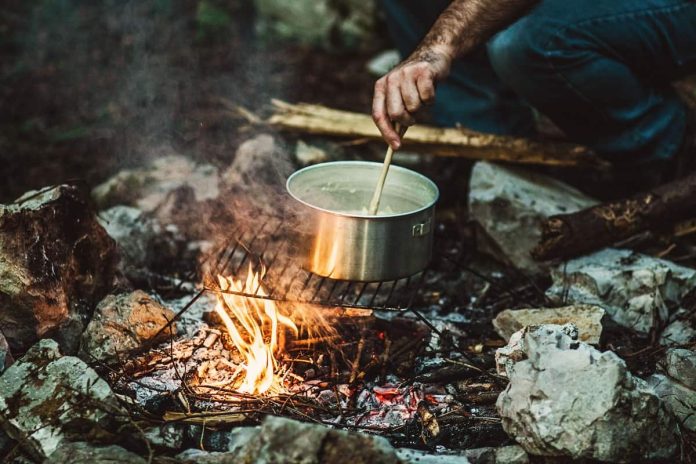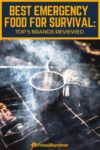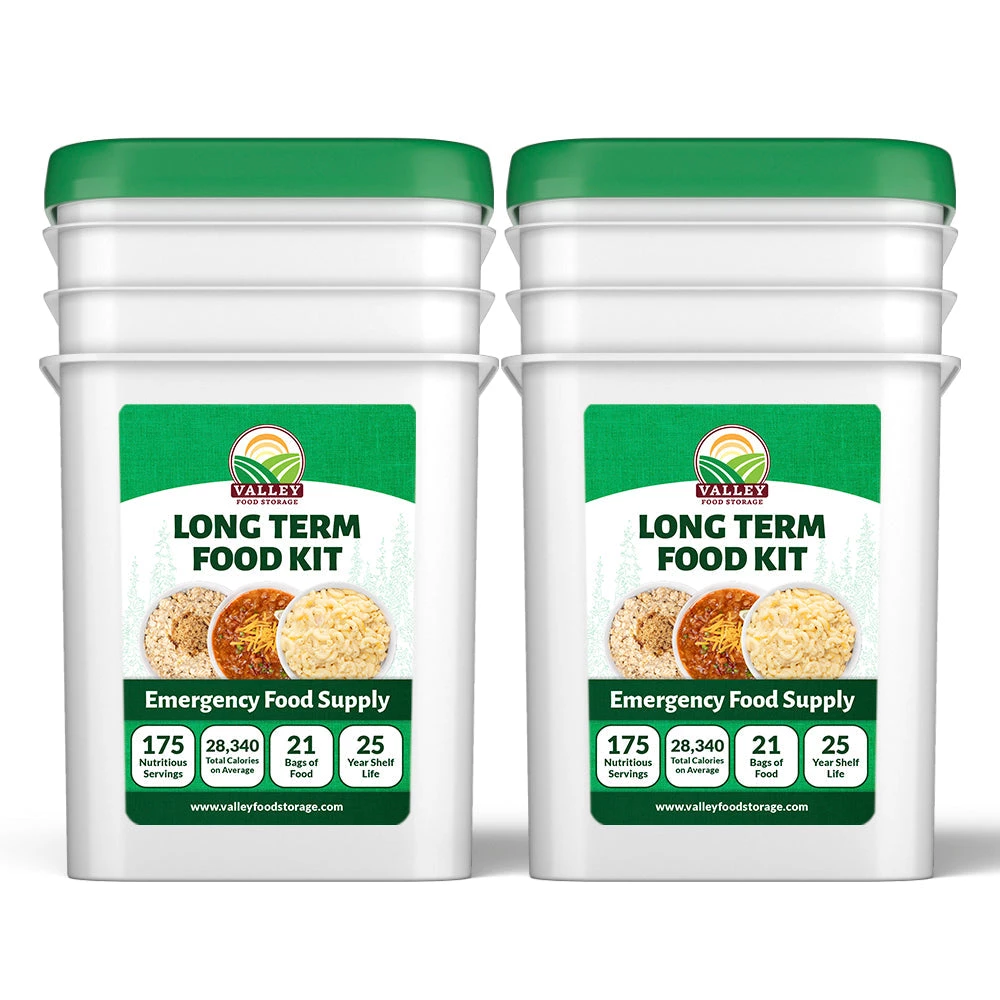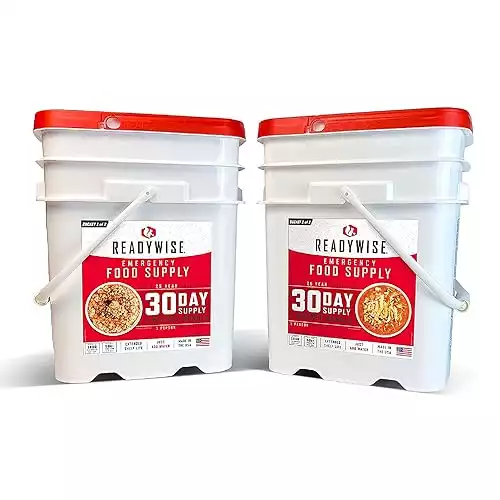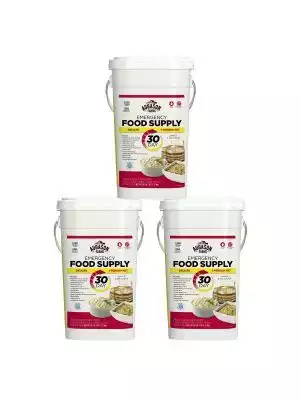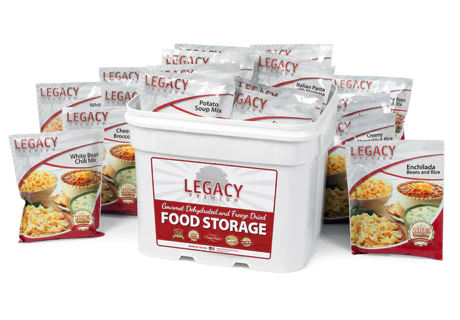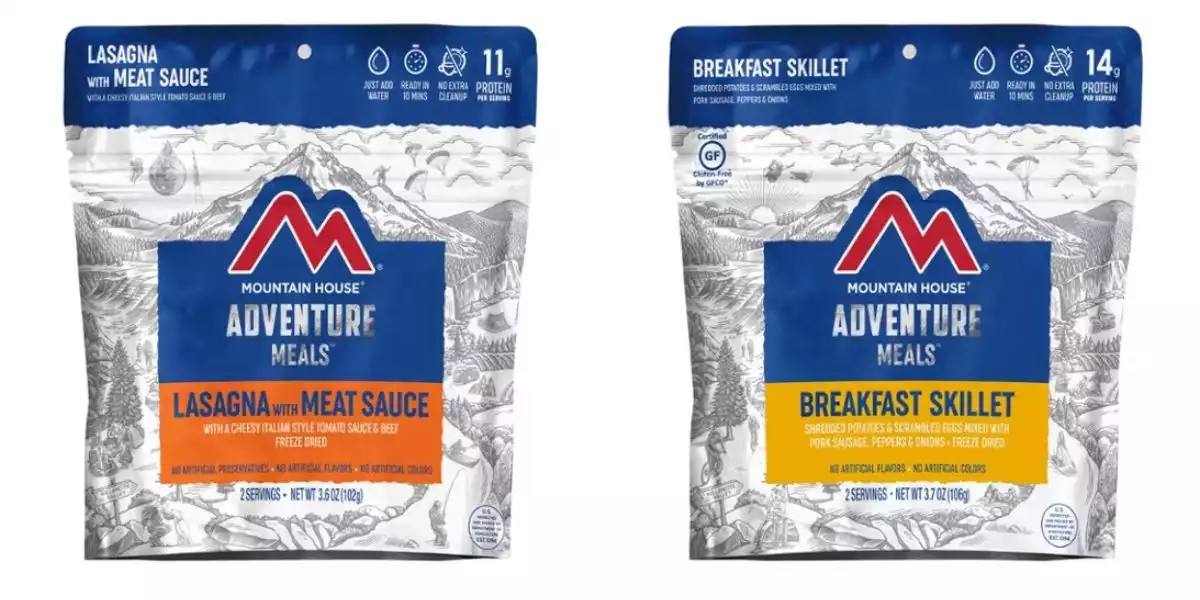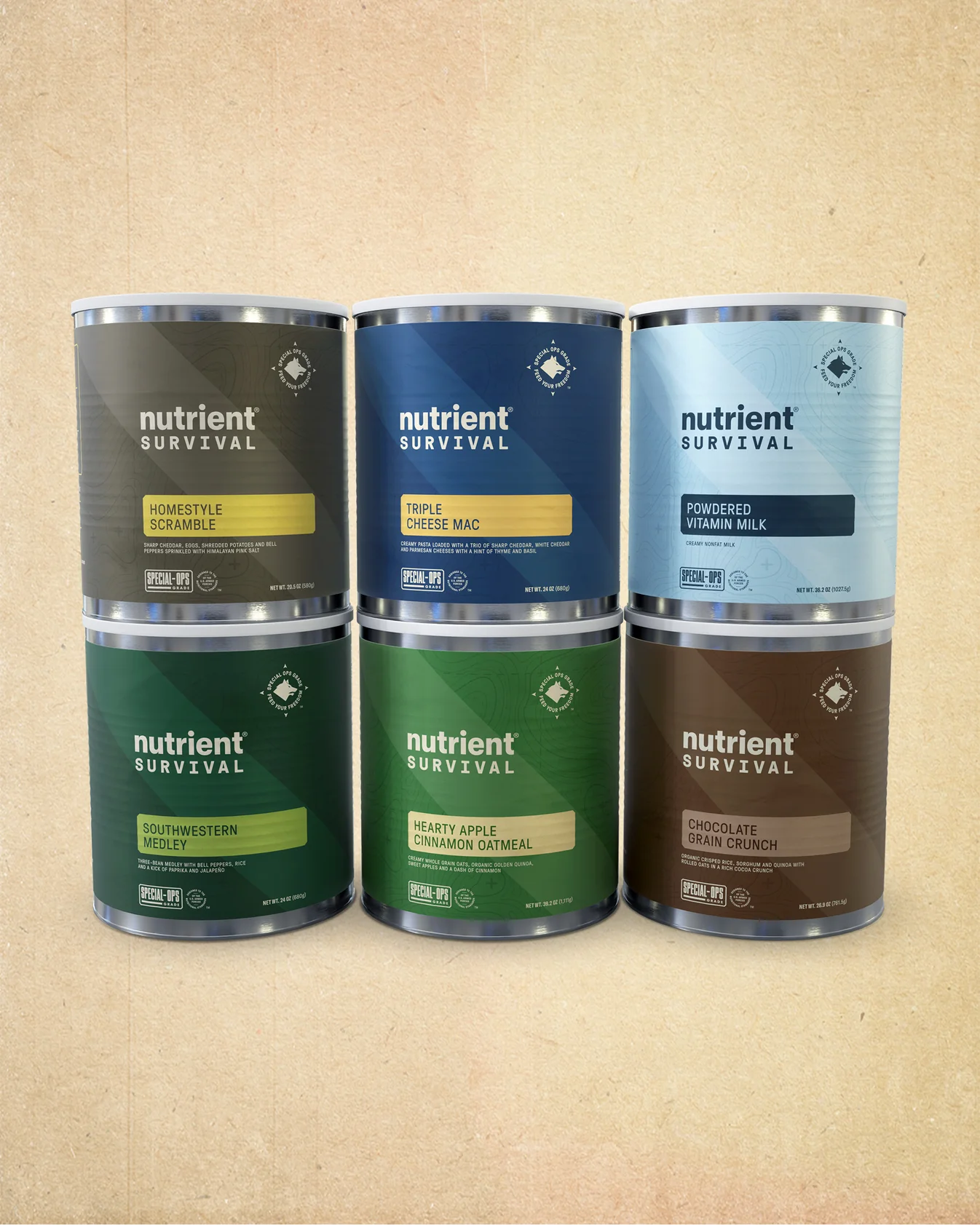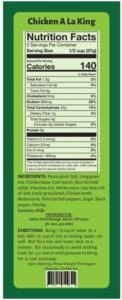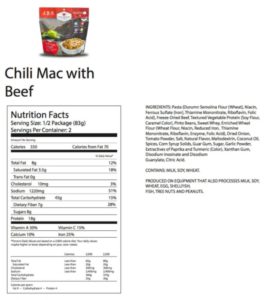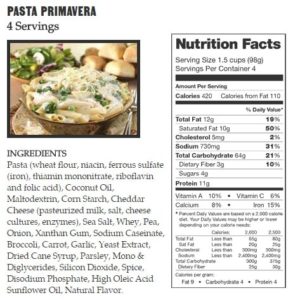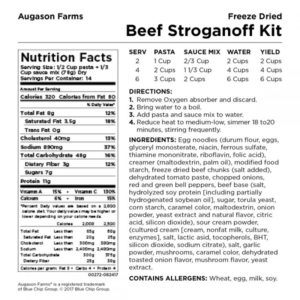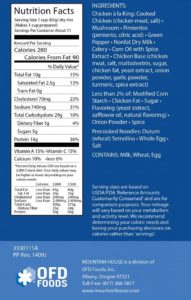Starting an emergency food supply is one of the most important things you can do to get prepared.
Yet trying to figure out the best emergency food can be daunting.
There are plenty of options for long-term emergency food.
In fact, your emergency food supply should consist of all these types of food.
But, for cost, convenience and reliability, it makes sense to buy some meals or kits from brands that specialize in emergency foods.
While there is no one “best” brand of emergency foods, I like some a lot better than others.
I’m going to review 5 of the top brands to help you make an informed decision.
(If you are on a restricted diet, these posts on gluten-free survival food and organic emergency food will also be helpful.)
Best Emergency Food – Quick Picks
Best Overall: Valley Food Storage
Good value (especially on large kits) and better nutrition than most, but meals do require cooking.
Best for New Preppers: ReadyWise Food Storage
Lots of options and good value on long-term kits. Most importantly, meals don’t require cooking, so no need to worry if you’ve stockpiled enough fuel.
Best Tasting: Mountain House
Meals contain high-quality ingredients (including real meat), are nutritionally balanced, taste great, and don’t require cooking – but come at a premium price
Best Low-Budget Option: Augason Farms
Very affordable kits plus tons of bulk ingredients, which allow you to build your own nutritious kit for cheap.
Best Packaging: Legacy Food Storage
Large kits are affordable, and the rectangular buckets are great for saving space, but nutrition is severely lacking and meals require cooking.
Best for Bug Out Bags and Low Sodium Needs: Nutrient Survival
Expensive and does not have many meal options, but the single-serving pouches are great for bugging out. They are also pretty much the only brand with low sodium and high protein.
Best Emergency Food Comparison Table
How to Compare Brands
Before we get into the emergency food brands, I want to discuss how I reviewed them.
I looked at the meal offerings and considered these factors:
1. Nutrition
The calories in emergency meals mainly come from carbohydrates and fats. Cheap, unhealthy emergency food brands don’t contain much more than this: they are usually just pasta or potatoes with a cheesy sauce thrown in for flavor.
By contrast, healthy emergency meals (or at least as healthy as you can reasonably expect with food that has a shelf life of 25 years) contain a good balance of carbs, fats, and proteins. They will also include some freeze-dried fruits and vegetables – usually corn and peas. These ingredients don’t have many calories but contain essential nutrients.
Tip: To quickly judge the quality of an emergency meal, look at the ratio of carbs to protein in grams. A ratio of 2:1 is good. A ratio of 3:1 is still pretty good. A ratio of 6 to 1 is very bad! Next, see if there is more than one vegetable in the meal.
2. Shelf Life
Anything less than 5 years is unacceptable for long-term food storage. Good emergency food brands have shelf lives of up to 25 or 30 years for meals. Bulk foods like eggs, cheese powder and meat should have a shelf life of at least 10 years
3. Packaging Material and Size
Most emergency foods are packaged in sealed Mylar pouches with oxygen absorbers. Ideally, these are also put in buckets to help the pouches withstand damage from disasters like hurricanes and flooding.
You’ll also find emergency foods in #10 cans. These are pretty indestructible. The downside is that #10 cans usually contain a lot of food, so you might not be able to eat it all. Once the can’s open, the food inside is usually good for 6-12 months.
4. Sodium Content
Most emergency meals are loaded with sodium. This much sodium could be disastrous for your health, especially while inactive and hunkering down.
5. Do the Meals Require Cooking?
Emergency meals are usually made with freeze-dried ingredients. Since these ingredients are pre-cooked, you can make the meals simply by adding water to rehydrate the meal. The meals will taste better if you cook them, but it’s nice to have the option of being able to prepare
However, the cheaper brands of emergency meals use uncooked pasta. These meals must be cooked. You must make sure you have an emergency stove and adequate fuel stockpiled.
6. Convenience
Planning emergency foods can be confusing. Many brands make this easier by offering “kits.” For example, you might start with a 1-month food kit of freeze-dried meals and essentials. This is much easier than mixing and matching freeze-dried veggies, meats, and grains to make your meals.
7. Taste
Taste is important when choosing your survival food. Just be warned that many better-tasting emergency foods taste good because they are loaded with sodium and chemical flavoring.
8. Cost/Value
For example, I find it worthwhile to spend a bit more for meals that have higher protein and contain vegetables.
Note that serving sizes can be very low. So, you need to look at the price per calorie (or price per day), as well as factoring in the quality of the ingredients.
Don’t Get Swayed By….
- Weight: Some emergency food brands boast that they are the “cheapest per pound.” The weight of a kit isn’t that useful when comparing options. Many brands load up on bulky foods (such as pasta) and skimp on foods like freeze-dried meat, fruits, and veggies (which you need for micronutrients).
- Servings: When buying survival food kits, you can’t just look at the listed number of servings included. You need to pay attention to calories. Read closely, and you’ll see that a “serving size” is usually around 200-300 calories. Do the math, and you’ll find that the emergency kits only provide around 1000 calories per day.
Best Emergency Survival Food Brands Reviewed
Valley Food Storage

Learn more about Valley Food Storage
Valley Food Storage is a good balance between everything you’d want from emergency food. They are affordable, have decent nutrition, and have a great variety. I love that you can buy variety kits or kits with just the meals you want.
Key Facts
- Great selection of kits and bulk ingredients
- Very good value
- Low protein and high sodium
- Good taste and texture
- Gluten-free and dairy-free options
What They Offer
Valley Food Storage mainly sells long-term food kits in buckets.
These include:
- Buckets by # of servings: The smallest kit has 175 servings. The largest has 4,200 servings!
- Buckets by # of days: These kits have 2,000 calories per day. They range from a 72-hour kit up to a 1-year kit.
Their 30-day emergency kit or 525-serving buckets are good for preppers just starting out.
Freeze-Dried Foods:
They also have lots of freeze-dried foods you can buy in individual pouches or buckets, such as:
- Dairy, Cheese & Eggs: 25-year shelf life, about 100 calories per serving
- Meats: 25-year shelf life, about 130 calories per serving
- Fruits and veggies: 14 different foods, 25-year shelf life, about 35-90 calories per serving
- Breakfasts and entrees: 6 breakfast options (approx. 160 calories per serving) and 12 entrée options (200-300 calories per serving)
Packaging
Like most emergency food, Valley Food Storage packages its products in Mylar bags with oxygen absorbers. If you buy one of their long-term kits, these bags will be in a sturdy bucket. After opening, the packs can be resealed.
Nutrition and Quality:
The big pro of Valley Food Storage is that they mostly use real ingredients without a lot of additives and preservatives.
However, the meals really lack when it comes to nutrition. They are low in protein (none of the meals actually contain meat) and most have tons of sodium. There are few vegetables in the meals, so there’s not much in terms of micronutrients either.
Despite this, the nutrition of Valley Food Storage meals is still better than other brands! If you supplement the meals with some of their bulk ingredients, you could end up with a filling, healthy (or healthy-ish) meal.
Price
Valley Food Storage kits are a great value. Depending on the size of the kit you get (larger kits are a better deal), the prices break down to:
- $1.50-$1.75 per serving
- $12-$14.50 per day (for 2,000 calories per day in their “per day” kits)
The price for their bulk ingredients is also very good. A lot of these are also available in kits, which are an even better value.
Note that most emergency food companies only sell entrees as variety packs or kits, which means you will probably get stuck with some entrees you don’t like much. I love that VFS sells kits with just one entree, so you can buy just the meals you actually like in bulk.
Best For: People looking for value and variety
Valley Food Storage products are a great all-around value, though you might want to add some freeze-dried meat and veggies to the entrees to improve the nutrition.
Read our in-depth review of Valley Food Storage
ReadyWise

ReadyWise (previously Wise) is a very well-known emergency food brand that has been around since 2008. One of the best things about them is that none of their meals require cooking.
They have a vast selection of emergency kits ranging from 72-hour starter kits to long-term kits. You can also buy foods individually to create your meals; however, the prices aren’t as reasonable when purchasing products separately.
Key Facts
- Kits are very affordable
- No cooking required
- Moderate protein
- Lots of variety in kits
- Gluten-free and organic options
- Very high sodium
- Individual meals and pouches are pricey
- Some bulk ingredient options
What They Offer
ReadyWise is best known for its emergency meal kits. These contain meal pouches which are packaged in buckets. There are currently 13 different entrees and 4 breakfast options.
They used to only sell buckets by serving size. But they got a lot of criticism for having so few calories per serving (just 150 to 280 calories per serving!). Since then, ReadyWise has also started selling buckets by # of days. These kits have 1,800 calories per day.
ReadyWise also has a huge selection of freeze-dried foods that you can buy in pouches or in bulk buckets.
Here’s a breakdown of what ReadyWise currently offers:
- Buckets by # of servings: The kits range from 52 servings to 4,320 servings. These kits only contain meals.
- Buckets by # of days: These range from 3 days to 1 year and have approx. 1,800 calories per day. These kits contain meals and bulk ingredients like banana chips and beverages.
- Buckets of freeze-dried bulk ingredients: Currently they have powdered whey, powdered eggs, meat, and some fruits and veggies.
- #10 cans: Instead of pouches, you can get bulk ingredients from ReadyWise in #10 cans. There are some cool options, like freeze-dried butter.
- Individual pouches: These are sold under the “Simple Foods” name. The shelf life is only 3 years!
- Outdoor Foods: This is what ReadyWise calls their line of meals designed for hiking. The meals are tastier because they actually contain meat and have more options, but the shelf life is 15 years instead of 25.
Packaging
ReadyWise Food packages its products in Mylar bags, which are in buckets. Each Mylar bag has around 8 servings in it. The packaging is reliable and convenient for emergencies. Depending on the product, the shelf life is 10 to 25 years.
There are also some products available in pouches (no bucket) and some in #10 cans.
Nutrition and Quality:
Like with most emergency meals, the meals in ReadyWise long-term kits are lacking nutritionally. They don’t have any real meat and hardly any vegetables. The sodium content isn’t as bad as with some other brands.
However, ReadyWise also has some “outdoor” meals and “everyday” meals in #10 cans that do contain real meat and are much more nutritionally balanced. These are much pricier than the meals included in kits though.
Price
If you want to buy individual pouches or entrees from ReadyWise Food Storage, it is pricey. However, as you start buying in bulk, the food quickly becomes affordable.
Best For: New preppers
The long-term kits are affordable and meals don’t require cooking. This makes them ideal for new preppers who might not have stockpiled adequate fuel.
Read our in-depth review of ReadyWise Food Storage
Legacy Food Storage
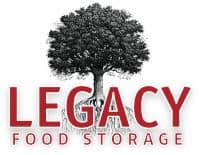
Learn more about Legacy Food Storage
Legacy Food Storage boasts the lowest price per pound of food and has high calories per serving. Their packaging is very reliable, and I love that the rectangular buckets are stackable and don’t take up as much space are round buckets.
On the downside, the ingredients in their meals are low quality. There is no meat and very few vegetables. The nutrition is severely lacking, and all meals require cooking.
Key Facts
- Good value on large kits
- Lots of bulk individual items to choose from
- Non-GMO
- High sodium and poor nutrition
- Can’t buy meals individually
- Outdated website is hard to use
What They Offer
Legacy Food Storage has 12 different entrées and 4 breakfast options. All of their meals are vegetarian, and six of the entrees are gluten-free. While 12 is a good number of meals, there isn’t too much variety in the meals. They are mostly pasta or a carb with a lot of cheese or creamy. The copious amounts of dairy do make the meals taste great though.
The entrees contain an average of 388 calories, and the breakfasts 437. They don’t sell any “by # of day” kits. However, they are very transparent about how many calories each of their kits contain.
Legacy Foods Storage currently offers:
- Long-Term Buckets: They have breakfast and entrée buckets, as well as just breakfast, just entrée buckets and a gluten-free entrée bucket. Buckets range from 32 servings to 4,320 servings.
- Freeze dried bulk ingredients: These are packaged in Mylar pouches. You can buy individual pouches or variety kits. There’s a good variety of fruits, veggies, dairy, eggs and meat. They also have some cool options, like peanut butter powder and coffee.
- Samples: Legacy does NOT sell individual pouches of their meals. So, if you want to try their meals before buying a kit, you have to purchase one of their sampler kits, which contain a variety of pouches.
Packaging
Legacy does an excellent job with its packaging. Not only do the Mylar bags contain oxygen absorbers but they are also nitrogen-flushed to remove even more air. All the meals have a shelf life of 25 years. The bulk freeze-dried ingredients mostly have shelf lives of 10-15 years.
Regarding convenience, the Mylar bags are resealable. Each only contains a small serving size. But, if you don’t consume the entire bag immediately, many of the products will last up to a year after the bag has been opened.
The bags are put into buckets, which are well-built. They are stackable and rectangular shaped to take up less space.
Nutrition and Quality
The main selling point of Legacy Food Storage is that their meals have a higher calorie count than most other brands. However, I’m concerned about where these additional calories come from.
Read the ingredients list of the meals, and you’ll see that they have added sugar (cane syrup). This is part of the reason that Legacy emergency foods taste so good.
Factor in the high sodium amount per serving (600-1000mg per serving), and you’ve got a tasty but unhealthy meal.
For a short-term emergency, all that sugar and sodium won’t matter. For a long-term crisis, it could take a toll.
Note all Legacy Food Storage products are vegetarian. If you add freeze-dried meat to the meals, the price per serving will increase dramatically.
Price
When you buy one of their emergency meal kits, the price per serving comes to approximately $2.60 to $3.50 per serving. If you were to consume 1,800 calories of their meals per day, this would end up costing $10.40 to $14 per day.
This cost is on par with most other emergency food brands. However, because Legacy Food Storage uses such cheap ingredients (it’s mostly just pasta and cheese) in their meals, the meals aren’t as good of a value as they seem at first.
Best For: Value and taste
If you don’t mind the poor nutrition, Legacy Food Storage kits are affordable, and the meals taste good.
Read our in-depth review of Legacy Food Storage
Augason Farms
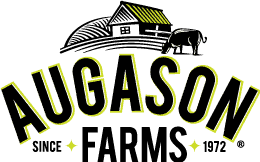
Augason Farms isn’t as well-known as the other emergency food brands. However, they are one of the best picks for people who are on a budget.
I love them because they have so many options for freeze-dried bulk ingredients, which makes it possible to build nutritious meals for cheap. However, this does take more planning than with other brands.
Key Takeaways
- Low sodium
- Very good price
- Huge variety of freeze-dried bulk foods
- Not many long-term kits
- Meals are low protein
What They Offer
Augason Farms mostly offers freeze-dried bulk ingredients. They have options that you won’t find from other emergency food brands. Great for foodies!
They have a good selection of freeze-dried meals too. Recently, Augason Farms also started offering these meals as part of emergency kit buckets. The biggest bucket is only for 30 days though.
Freeze-Dried Bulk Ingredients (Pouches and #10 cans; some items are available in buckets):
- Dairy and Eggs: 20+ year shelf life, about 80 calories per serving
- Bakery: 10+ year shelf life, about 160 calories per serving
- Meats and Protein: 30-year shelf life, about 180 calories per serving
- Grains and beans: 30-year shelf life, about 150 calories per serving
- Fruits and veggies: 14 products, 30-year shelf life, about 115 calories per serving
Emergency Meals (Pouches and #10 cans)
- Breakfasts: 4 breakfast options such as granola and omelets; 25-year shelf life, about 278 calories per serving
- Entrees: 10 options, such as chili macaroni with beef and chicken alfredo; 25-year shelf life, about 270 calories per serving
Emergency Food Kit Buckets:
- 24 hours to 30-day buckets
- Breafast and entrée bucket:
- Entrée-only bucket
- Breakfast-only bucket
Packaging
Most of Augason Farms products come in #10 cans with a shelf life of up to 30 years. There are a lot of servings per can, which may be inconvenient if you can’t use up the item quickly.
Luckily Augason Farms also offers a lot of their products in individual Mylar pouches. The pouches are resealable. The variety buckets which contain several pouches are the best deals.
Nutrition and Quality
Meals by Augason Farm tend to have more calories than other brands (about 240-300 calories per serving).
But, as tends to be the case with emergency food, the ingredients are low-quality. Meals are mostly just pasta covered in cheese sauce. There aren’t many vegetables and no meat. Even the “chicken” meals usually don’t contain any chicken (just chicken flavoring).
There is a lot less sodium in their meals than you’ll find in other brands. However, the nutrition is still very lacking. You’ll really want to get one of their veggie variety buckets and use it to supplement the meals.
Price
Augason Farms has one of the cheapest 1-month food supply kits you can buy. (for 307 servings, 56,600 calories)
Just note that many “servings” are low-calorie sides like cheese powder or mashed potatoes.
Best For: Building your own kit for cheap
The large selection of individual meal pouches and bulk ingredients makes Augason Farms great for preppers who want to take more of a DIY approach to building their kits.
Read our in-depth review of Augason Farms.
Mountain House

Learn more about Mountain House
Mountain House “Adventure Meals” are well known in the backpacking and thru-hiking community. Over the past several years, they have branched out to include emergency preparedness food kits. This line of food is called “Just in Case”.
The “Just in Case” foods are exactly the same as their “Adventure Meals.” The only difference is that they tally up the calories for you and put the pouches in a bucket. The Adventure Meals have many more options too.
Oddly, the cost per serving in their kits is the same as if you buy the meal pouches individually.
Because of this, I don’t recommend the Just in Case kits: buy individual meal pouches instead. Then you can choose exactly which meals you want and get more variety.
Note that Mountain House does NOT offer much in terms of freeze-dried foods or bulk foods (they only have a few cans of meat and crackers). They do have a great selection of freeze-dried entrees, breakfasts, and desserts.
Key Takeaways
- Quality ingredients and meals actually contain meat
- Balanced macronutrients
- No cooking required
- 30-year shelf life
- Lots of variety
- Meals are expensive!
- Kits are not in buckets
- Great value on freeze-dried meat
- No freeze-dried fruits, veggies, or dairy
What They Offer
Mountain House offers a few “Just in Case” kits. The kits work out to a bit more than 1,700 calories per day. The smallest kit is for 3 days and the largest is for 1 year. There are 11 different entrees and 4 breakfasts in the large kits.
You can also buy Just in Case meals in #10 cans. They also have a good selection of freeze-dried meat in #10 cans. These are surprisingly affordable.
Note: The Adventure Meals line contains 25 options. If you want more variety, you’ll need to buy these individual meal pouches.
Packaging
Mountain House products come in either pouches (with 2-4 servings each) or #10 cans (with 8-10 servings). There are also “Pro Paks,” packaged to reduce weight and take up less space in your backpack.
They do NOT have buckets. If you buy pouches of their food, I recommend putting them in buckets to protect them from damage.
Previously, Mountain House said the shelf life of pouches was 7 years. However, they now offer a “Shelf Life Taste Guarantee” of 30 years on all their pouches and cans (except for some desserts).
I like the Mountain House pouches and Pro Paks. However, their #10 cans don’t contain any pouches. This makes them impractical to use during an emergency: you’ve got to use up all 10 servings within a week of opening the can.
Nutrition and Quality
Unlike other emergency food brands, Mountain House focuses on the quality of ingredients.
Their entrees contain meat and not just textured vegetable protein. They are one of the best-tasting emergency food brands without adding tons of salt and chemical flavoring).
There is a lot of protein in each serving, as well as balanced macronutrients. This is why thru-hikers love Mountain House. Since meals actually contain some meat and vegetables, the micronutrient content is better than with other brands.
Just note that Mountain House meals have some of the highest sodium content of any emergency food brand. That’s saying a lot since the sodium in emergency meals tends to be high!
Price
Mountain House is one of the pricier options for emergency food. The price per serving of the kits is approximately $5. Bear in mind that the calories per serving is low. If you want to eat just Mountain House meals during an emergency, it will cost you approximately $30-$35 per day!
The thing that really annoys me is that the price-per-serving in kits isn’t noticeably cheaper than when you buy individual Adventure Meal pouches.
Other than the fact that the calories are calculated for me, why would I want to buy a large kit? It’s smarter to buy individual pouches. Then you’ll be able to choose exactly the meals you want. There are more options with Adventure Meal pouches, too, so you can build a kit with more variety
Best For: Bug out bags and for people who have a large budget
Mountain House meals require no cooking, have lots of protein and use quality ingredients. This quality comes at a price, so I’d only recommend their meals for long-term emergency planning if you have a larger budget. They are great for your Go Bag though!
Read our in-depth review of Mountain House
Nutrient Survival

Learn more about Nutrient Survival
Nutrient Survival is a newer brand of emergency food that advertises itself as being “6x more nutritious than survival food.” They also are one of the only brands to offer single-serving pouches and bug-out kits.
Key Facts
- Meals are high-protein and low-sodium
- Fortified to provide complete nutrition
- Only 3 entrée options but have shakes and meal bars
- Great taste and texture
- No cooking required
- Single-serving pouches available
- Pricey
What They Offer
Nutrient Survival doesn’t have too many options when it comes to meals. They currently have 3 entrees (lasagna, southwestern medley, mac and cheese) and 3 breakfasts (homestyle scramble and two types of granola).
In addition to meals, Nutrient Survival has some staples (eggs, milk, pnb), beverages like shakes and fortified coffee, and snacks like meal bars.
You can buy foods individually, in bundles, or as part of kits.
The kits can be broken down into these types:
- Daily kits: Contain meals in #10 cans plus powdered milk
- Kits in buckets: These contain meals and foods in pouches.
- On the go kits: These contain single-serving meal and food pouches
*Trying to make sense of the kits can be annoying. That’s because Nutrient Survival gave their kits trendy names like “Black Scout Survival Bucket” and “City Prepping Survival Bucket.” You basically have to read through the description of each kit to figure out what it contains and then decide whether it’s right for your needs.
Packaging
Nutrient Survival has #10 cans and pouches of food. They are also one of the only brands to offer single-serving pouches of food. This is very convenient for bug out bags.
The shelf life varies depending on the packaging method.
- Single serving pouches: 15 years
- Pouches: 15 years
- Cans: 25 years
Nutrition and Quality
Nutrient Survival really does meet their claims about having more nutrition than other brands. However, the nutrition doesn’t come from the ingredients in the meals. Rather, most of those nutrients are because each meal is heavily fortified.
While the food itself has a long shelf life, vitamins tend to break down fairly quickly (read about how to store vitamins here). So, if you wait several years to eat the meals, they might not be as nutritious as the label states.
The quality of the actual meals is similar to other brands: you mostly get a lot of carbs with very little in terms of vegetables. There is no real meat in the meals.
Price
Regardless of how you purchase Nutrient Survival meals, it ends up being very expensive. It breaks down to approximately:
- #10 cans: $5.40-$5.80 per serving
- pouches: $5.20 per serving
- Single-serving pouches: $6
The 90-day kit contains 122,040 calories, which is actually only 1,356 calories per day. If you were to eat 1,800 calories per day, the kit would only last 68 days. This ends up costing approximately $24 per day.
Their bug-out kits also end up being pricy. It breaks down to $28 to $42 per day.
Is this cost worth it? It may be if you need low-sodium meals and don’t want to build your own kit. The bug out kits are also very convenient and the single-serving packaging is great. Otherwise, it’s really pricey for a small selection of meals that happen to be fortified.
Best For: Bug out bags and people willing to pay more for low-sodium meals
Read our in-depth review of Nutrient Survival
Wrap Up
Every brand featured offers a decent product, and their kits will provide a practical and convenient long-term food storage solution for most people.
The differences come down to the following:
- Price
- Nutrition and quality
- Packaging
Decide which combination of these is important to you, and you should be able to make the right choice with the information provided in this article.
Check out the links below to investigate each company further.

